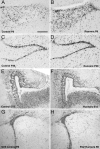Running in pregnancy transiently increases postnatal hippocampal neurogenesis in the offspring
- PMID: 16537457
- PMCID: PMC1389702
- DOI: 10.1073/pnas.0502644103
Running in pregnancy transiently increases postnatal hippocampal neurogenesis in the offspring
Erratum in
- Proc Natl Acad Sci U S A. 2006 May 9;103(19):7530
Abstract
Voluntary wheel running of mice in pregnancy and lactation led to a twofold increase in hippocampal precursor-cell proliferation and in the number of Prox1-expressing lineage-determined cells at postnatal day 8 (P8). At P36, the number of newly generated granule cells approximately doubled, resulting in a 40% higher total number of granule cells in pups from running dams as compared with controls. Cell proliferation at embryonic day 15 (E15), in contrast, was decreased in the progeny of exercising mice, and the birth weight was reduced. At P49, body weight had normalized, and hippocampal neurogenesis was not different between the two groups. mRNA for FGF2 was expressed at higher levels at E15 and P8 in runner pups, whereas VEGF was increased only at E15. Insulin-like growth factor did not show differences at any time point. At P36, no differences for any of the factors were found. Our data indicate that maternal behavior and physical activity affects infantile growth-factor expression and can transiently stimulate postnatal hippocampal development in the offspring.
Conflict of interest statement
Conflict of interest statement: No conflicts declared.
Figures



References
-
- Cameron H. A., McKay R. D. Nat. Neurosci. 1999;2:894–897. - PubMed
-
- Montaron M. F., Petry K. G., Rodriguez J. J., Marinelli M., Aurousseau C., Rougon G., Le Moal M., Abrous D. N. Eur. J. Neurosci. 1999;11:1479–1485. - PubMed
-
- Eriksson P. S., Perfilieva E., Björk-Eriksson T., Alborn A. M., Nordborg C., Peterson D. A., Gage F. H. Nat. Med. 1998;4:1313–1317. - PubMed
Publication types
MeSH terms
Substances
LinkOut - more resources
Full Text Sources

